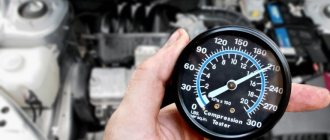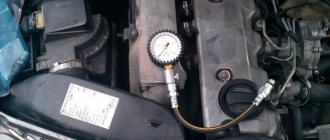Engine compression and how to check it. Many people with this problem turn to the service, where they can hang noodles on their ears. If anyone is interested, read it) Thank you for your attention)
Engine compression, or rather the compression of engine cylinders, is an indicator of the viability of the engine. According to the scientific definition of engine compression, it will look like this - “The maximum air pressure in the combustion chamber achieved when the piston reaches top dead center during the compression stroke.” - which is of course correct.
As mentioned earlier, engine compression is one of the main indicators of the health of the engine. Many processes in the engine depend on the level of compression - fuel combustion, oil consumption, ease of starting the engine (with low compression, the engine does not start well), sneezing and farting of the engine as well can be caused by low compression or its absence in one or more engine cylinders; the engine may misfire due to weak compression in the cylinders. Low compression can also cause a drop in engine power; more precisely, when engine power drops, it is worth checking the compression.
There is no compression, compression has disappeared, let's look at the reasons for the disappearance of compression. The signs of the disappearance of compression are described above. Let's return to the reasons for the loss of compression. There can be quite a lot of them.
• Engine overheating may well be the main cause of low compression. With severe overheating, scuffing of the pistons and cylinders often occurs in the cylinders, the pistons can melt and burn out, there have been cases when the piston burned inward, that is, a hole formed in the middle of the piston. VAZ engines also often suffer; when overheated or due to service life, the piston ring partitions have a habit of crumbling, as a result of low compression, the engine farts, does not run, and needs repair.
• A malfunction in the gas distribution system can also cause a loss of compression. A valve burns out - compression is 2-3 - open the head, check the valves, change them, and grind them in.
• The timing belt or chain is broken - you’ll be lucky if the valves don’t bend, a new belt, drive on - low compression - most likely the valves are bent - remove the valve head and change the valve. Several teeth have slipped on the gear, the marks were wrong when installing the camshaft - at least incorrect valve timing , the engine farts, troits, works unstably, does not pick up or drop speed - at most the valves are bent.
• Valve adjustment - there is no clearance, the valve does not close, does not hold (one of the reasons why valves burn out), subsequently low or no compression. Too much clearance - the valve does not open enough due to incorrect adjustment or wear of parts, less flow enters the cylinders air, signs - a knock under the valve cover, is not difficult to recognize, not as scary as a jammed valve.
• A blown cylinder head gasket is an obvious reason; it is difficult not to notice when the engine is running. Or the gasket is burnt out and gases escape either into the cooling system or into the oil line.
• Wear of piston rings, pistons and wear and ellipse on the cylinder walls is also often accompanied by increased oil and fuel consumption.
• Cracks in the cylinder head.
• A clogged air filter makes it difficult for air to flow into the cylinders, and therefore also affects compression.
How to check compression in engine cylinders
To check and measure compression, we need a special device - a compression meter. Essentially, it is a pressure gauge, with extensions attached to it so that you can get to the most inaccessible hole, as well as adapters for different sizes of spark plugs. Compression gauges are also available separately for diesel and gasoline engines, since the compression in the cylinders of a diesel engine is an order of magnitude higher than that of a gasoline engine. At one time, two sets of compression gauges cost me 50 bucks, for some reason the diesel one was more expensive.
So, here’s how to check engine compression - in principle, if you have a compression gauge, then everything else will be found on its own. Before you begin all preparations for measuring compression, make sure that you are dealing with a well-charged battery and a live starter. This job requires 2 people.
— First, we need to unscrew all the spark plugs, but before that, clean out all the debris around the spark plugs (blow it out with a compressor, if any) so that it doesn’t get into the combustion chambers.
— Next, remove the air filter.
-Disconnect the power terminal of the ignition coil (on the carburetor from the distributor)
— Then we carefully screw the adapter into the hole for the spark plug (for diesel engines you will have to unscrew the injectors) and turn the starter while opening the throttle (carburetor) 100% so that the cylinder is completely filled.
— We check each cylinder.
— We look at the pressure gauge readings, analyze the spread in the readings between all cylinders.
If you notice that your engine is running worse, then it may be time to check the engine compression level. What should be the compression of VAZ 2114 8 valves? How can I check it? We will tell our readers about this in this article.
Why is verification needed?
The compression of the VAZ 2114 8 valve engine indicates the working condition of the engine. This indicator determines the engine power and its service life. The process of measuring the compression of a VAZ 2114 8-valve engine should be carried out at least every 20-30 thousand kilometers. In addition, this should be done before purchasing a car.
VAZ 2114 car with 8 valve engine
Compression itself is the level of pressure that is generated at the end of the compression stroke in the cylinder. That is, if you notice that the engine of your VAZ 2114 8 valves has become worse, namely, the consumption of gasoline and motor fluid has increased, and the power has decreased, then you need to check it. Engine diagnostics first of all includes checking the compression level. This is one of the few procedures that will reveal the condition of the power unit without disassembling it. But what should be the compression in a VAZ 2114 8-valve engine?
This question came to every car enthusiast. If its level is too high, then less gases will enter the engine crankcase. Accordingly, a more saturated gas flow will perform useful work. But if the level is excessively low, then this will affect the power of the car and the maximum possible speed that the car can reach. In addition, the acceleration dynamics will decrease by an order of magnitude. So what should the compression of the VAZ 2114 8 valves be?
The normal level should be at least 10 bar.
This is how engine compression is measured.
In this case, the difference between the cylinders should not be more than 1 bar. If, as a result of the measurement, you find that from the first to the fourth cylinder the pressure level is 11, 12, 11, 12 bar, then the engine is operating normally. But if the indicators differ significantly, for example, 11, 8, 13, 10, then it is necessary to repair the car. Ideally, the compression for a VAZ 2114 8-valve engine should be 14 bar in each cylinder.
What influences this indicator?
These proportions are influenced by many factors:
- Volume of incoming gas. In particular, to ensure normal pressure levels, the air filter should be changed on time.
- Setting the valve timing.
- Incorrect level of clearance adjustment in the drive of one of the eight valves.
- Motor operating temperature. If it is significantly lower, then the pressure level, accordingly, will be an order of magnitude lower.
- Defects in oil scraper rings, as well as burnout of valves.
- Gasoline, which for some reason enters one of the cylinders.
This is what a threaded pressure measuring device looks like
Compressometer
Measuring compression indicators is best done with a compression meter operating on the principle of a pressure gauge. If the latter measures tire pressure and is designed for light loads, then the compression meter is a more powerful unit. Compare the pressure inside the engine and the tire, and then the difference between the two devices will become visible. However, the principle of their functioning is largely similar.
Conventional compression gauge
Today, there are three types of compression meters.
- For gasoline units.
- For diesels.
- A universal option used for diagnosing power units of any car.
In addition to the fact that compression meters come in different types, they also differ in models.
A compression meter is a diagnostic unit that is part of the mandatory tools for maintenance. Experienced motorists use it to analyze the technical condition of the engine without using expensive service stations. A good compression meter allows you to carry out diagnostics yourself, without the help of an assistant, which is also considered a big plus. As soon as I noticed problems with the engine, I took it and checked it.
A prerequisite for a high-quality meter is the presence of a tip on it that allows you to screw the measuring device into the spark plug hole. Without such a threaded output, the measurement accuracy is reduced significantly.
It is also recommended to purchase a meter that is equipped with a compression breather in the tip itself, which is screwed into the spark plug hole. If the valve is located directly below the scale, the readings will be less accurate.
A conventional compression meter is most often used to determine the compression level in garage conditions. However, this measurement can be called uninformative, although it is still possible to clarify the overall picture.
For a more complete diagnosis, it is recommended to carry out the test using special equipment, preferably at a service station. For example, such an installation as the AGC is used to monitor the condition of the CPG. The measurement option is no different from the compression meter, but the AGC helps to measure the vacuum values, not the compression values in the cylinders.
AGC is also used to detect leaks that are associated with the combustion process. The installation helps determine the effectiveness of valve fit, assess the condition of the pistons, and detect coking or stuck rings.
We carry out checks for an 8 valve car
So, the procedure for checking the motor yourself is not particularly difficult. Having the necessary skills and a device with which you can measure pressure, the procedure can be carried out independently. Naturally, for this you will have to follow certain requirements, which are listed below. If you know what the compression should be in the internal combustion engine, then you can start working.
Step by step instructions
The first thing you will need to measure the pressure level in the engine is a device with which you will do this. How can we measure this coefficient? The device for this is called a “compressometer”. Such a device can be of several types:
- universal device;
- threaded;
- flexible;
- clamping
This is what the pressure measuring device looks like disassembled
You will need to find such a device. Also, in this matter you will need the help of a friend, since you will have to simultaneously perform some actions both inside the cabin and in the engine compartment. In addition to the compression gauge, prepare a wrench for removing the spark plugs. Please note that it is better not to perform any work if the battery is not working. Therefore, fully charge your battery. So, let's start checking:
- First, get behind the wheel and start the engine. Let it idle and warm up to 90 degrees, that is, to operating temperature.
- After this, open the hood and take the key to remove the spark plugs. You need to remove the high-voltage wires, and then dismantle all the spark plugs. The wires fit to the spark plugs, you just need to pull them out.
- Now remove the ECU fuse to avoid possible damage to the device.
- When the spark plug is dismantled, you need to install your device in its hole to check the pressure level. Do this carefully so as not to damage the threads.
- Now you will need a friend's help. Ask him to sit in the driver's seat. The assistant must press the gas pedal all the way so that the throttle valve can open completely.
- Then turn on the starter and turn the crank pulley with it. This is done until the readings on the compression gauge stop increasing. As a rule, this takes no more than 10 seconds. In this case, the crank pulley must rotate, and its rotation speed should not exceed 100 rpm.
- Now you can read the received readings. Better write them down. Remember what the compression should be and compare these readings with the received ones. Once the readings are recorded, the device's needle can be set to zero.
- This procedure should be repeated for each cylinder of the VAZ 2114 8 valve engine.
What does a drop in compression mean?
A drop in compression in a car engine, detected when the throttle valve is open, will allow us to draw the following conclusions.
- The camshaft cam is worn unevenly or is defective.
- One of the valves is not assembled correctly, causing it to become stuck.
- The valve does not fit tightly to the seat.
- Carbon deposits have appeared on the sealing cuffs, automatically reducing the pressure.
- The inter-ring bridges of the piston are destroyed.
- The seal is broken, which may be caused by a crack in the combustion chamber.
- Cracks formed in the cylinders themselves.
- There are malfunctions in the operation of the GDS mechanism.
Finally, a video on how to measure compression correctly.
Always check the cylinder compression level or compression as this is important. The data obtained must correspond to the values indicated in the service book.
Comments and reviews
Ivan Ivanovich Baranov
Experience working at a service station:
View all answers
Avtozam.com - your assistant in car repair and maintenance
Your use of this website constitutes your agreement that your use is at your own risk.
Engine compression indicates the condition of the engine, its service life, power, and torque. This procedure must be performed every 20-30 thousand kilometers, as well as before purchasing a car. Even when checking at a service center, YOU will need knowledge on how to correctly measure compression, because service people love to deceive and make money from you.
Compression is the pressure created in the cylinder at the end of the compression stroke. Another term is appropriate here: Engine compression ratio. Engine compression ratio What compression should be in the cylinders of a VAZ engine? Normal engine compression is at least 10 bar (1.0 MPa), and the difference between the cylinders should not exceed 1 bar (0.1 MPa).
If your compression is 11-12-11-12 from cylinders 1 to 4, then the engine is fine, but do not forget to adjust the valves every 2500 km. If you have 11-9-12-11, then you need to look for the cause and make repairs, because driving in such conditions will only kill the engine. How much should the ideal compression be? The ideal compression should be 14 bar for an 8-valve engine in each cylinder with minimal variation (14-14-14-14). How to measure compression? There is a special device for measuring compression, it is called a compression meter.
These devices come in two types: clamping, universal, flexible and threaded. How to measure engine compression? To check the compression we need a spark plug wrench, a charged battery and a compression gauge. You also can’t do without an assistant. 4) PPPPP The assistant presses the gas all the way and starts the car within 6-10 seconds.
5) PPPPP We remember the compression gauge readings and carry out similar operations on the remaining cylinders. Low and different compression in the engine, what to do? If, after checking the compression, the compression meter shows below 10 bar in at least one cylinder, then you urgently need to find out the cause and fix the problem, otherwise you risk losing compression in the remaining cylinders. If for example you don't have enough compression in the 1.4P and any other cylinder,
2) Spray oil into the hole that appears. 3) We measure the compression again.
If, after re-measuring, the compression has increased, it means
rings are worn out. If the result remains the same then
valves are burnt out or jammed. Stiff valves can be adjusted, and burnt valves can be replaced. High compression in the engine.
Main reasons. Don't be too happy if your compression readings are off the charts, this is in no way indicative of how cool your engine is. As stated above, the ideal compression for an 8-valve engine is 14-14-14-14. If your compression is higher than these numbers, then it’s time to think about malfunctions. High compression can damage the partitions of the pistons and tear the cylinders. The following are the main causes of increased/high compression:
Greater compression is created due to excess oil in the cylinder, which is why it is sometimes also called oil compression
2) PPPPP The oil scraper rings are worn out or stuck.
(In such cases, oil consumption is inevitable. Check the oil level:
Also pay attention to starting the engine after a long period of parking, for example, in the morning. When oil is consumed in the engine, the exhaust will be black). 3) PPPPP There may be carbon deposits in the cylinders.
Try to get rid of it by decoking. If you encounter the problems outlined below, it is possible, BUT NOT FAR A FACT, that your engine has insufficient compression. Therefore, you don’t need to pay attention to the signs, but you just need to measure the compression. 2) PPPPP PHigh fuel consumption (How to increase engine compression in other ways? There are several options for increasing compression without repair. These operations do not guarantee an increase in compression, but you can try.
But it is still recommended to eliminate the malfunction by mechanical action to eliminate the malfunction: re-install the rings or replace the valve. I tried it myself, it really works. The valve could be jammed and therefore not close, resulting in a compression leak. 2) PPPPP Roskoksovka removes carbon deposits and excess oil in the cylinder.
Engine Lada Vesta
Products from the assortment of Dustershop77 on the topic of the article: Image[/td]
| vendor code | Name | Manufacturer | Price | Availability | Add to cart |
| DC1822-8200291355 | Crankcase gas recirculation valve Renault 8200291355 | Original | 6900 / 5500 rub. Discount: 4900 rub. | 2 | |
| DC380-ASAM-30376 | Lower radiator support cushion 7700430992 / 215081131R ASAM-SA 30376 analogue | Analogue | 150 / 100 rub. Discount: 80 rub. | 4 | |
| DC1644-140328698R | Intake manifold gasket H4M original 140328698R | Original | 700 / 600 rub. Discount: 400 rub. | 4 | |
| DC1211-8200132254 | Fuel injector for K4M engine original 8200132254 | Original | 2900 / 2200 rub. Discount: 1900 rub. | 4 | |
| DC919-226A41772R | Oxygen sensor lambda probe upper Duster, Vesta and other engines. H4M 1.6 226A41772R / 226901841R / 226906393R | Original | 4500 / 4200 rub. Discount: 3900 rub. | 2 | |
| DC619-8200048024 | Expansion tank cover original Renault 8200048024 | Original | 700 / 500 rub. Discount: 350 rub. | 2 | |
| DC1321-161757436R | Throttle valve gasket H4M/F4R original 161757436R | Original | 800 / 600 rub. Discount: 550 rub. | 2 | |
| DC1738 | Fuel pump fuel filter mesh Renault Duster, Captur, Terrano, Vesta, etc. 2.0 / 1.6 (Masuma) | Analogue | 800 / 500 rub. Discount: 350 rub. | 3 | |
| DC1398-30777 | Gasket for fuel pump ring ASAM 30777 | ASAM | 300 / 250 rub. Discount: 200 rub. | 3 | |
| DC1740 | Fuel filter for submersible fuel pump Renault Duster, Captur, Terrano, Vesta, etc. 2.0 / 1.6 (LYNX) | Analogue | 2100 / 1800 rub. Discount: 1500 rub. | 1 | |
| DC1766 | Throttle valve gasket repair kit K4M/F4R (large+small) Balakovo PTP64 | Analogue | 300 / 200 rub. Discount: 150 rub. | 2 | |
| DC981-FCR210114 | Electric fuel pump FRANCECAR FCR210114 | Analogue | 1500 / 1200 rub. Discount: 1100 rub. | 1 | |
| DC1200-BK64105/30598 | Fuel pump ring with gasket | Analogue | 1000 / 700 rub. Discount: 500 rub. | 1 | |
| DC1746 | Membrane of the crankcase gas recirculation valve Renault Duster, Captur, Terrano, etc. (KVKG membrane F4R 2.0) | Analogue | 2200 / 1900 rub. Discount: 1600 rub. | 2 | |
| DC1322-224332428R | Ignition coil 1.6 H4m original 224332428R | Original | 3500 / 3000 rub. Discount: 2600 rub. | 9 | |
| DC1682-6001549070 | Fuel vapor absorber original 6001549070 | Original | 4000 / 3200 rub. Discount: 2800 rub. | 1 | |
| DC1643-140323253R | Intake manifold gasket H4M original 140323253R | Original | 2000 / 1800 rub. Discount: 1600 rub. | 2 | |
| LRT-002/6001548140 | Washer reservoir is not original, ANALOGUE 6001548140 | LOGEM | 1000 / 900 rub. Discount: 500 rub. | 1 | |
| DC382-ASAM-30494 | Expansion tank ASAM-SA 30494 (7701470460) | Analogue | 1000 / 700 rub. Discount: 600 rub. | 1 | |
| DC955-150100565R | Oil pump for F4R original 150100565R | Original | 7500 / 6900 rub. Discount: 6600 rub. | 1 | |
| DC1314-135101KT0A | Front crankshaft oil seal H4M original 135101KT0A | Original | 900 / 700 rub. Discount: 550 rub. | 2 | |
| DC1320-161191KA1B | Throttle valve H4M original 161191KA1B | Original | 35000 / 29900 rub. Discount: 28300 rub. | 1 | |
| DC1664-21179113201000 | Fuel injector VAZ 1.8l 21179 original 21179113201000 | Original | 1800 / 1500 rub. Discount: 1300 rub. | 4 | |
| DC2457-8200291355 | Crankcase gas recirculation valve - analogue 8200291355 | Analogue | 4000 / 2400 rub. Discount: 1900 rub. | >10 | |
| 6001548140 | Washer reservoir Renault 6001548140 original | Original | 2000 / 1700 rub. Discount: 1500 rub. | 1 | |
| DC957-8200665520 | Starter K4M 1.6 original 8200665520 | Original | 13000 / 11500 rub. Discount: 10500 rub. | 1 | |
| DC1302-166008992R | Fuel injector for H4M engine original 166008992R | Original | 3500 / 2600 rub. Discount: 2400 rub. | 4 | |
| DC1315-122791HC0A | Rear crankshaft oil seal H4M original 122791HC0A | Original | 2000 / 1700 rub. Discount: 1400 rub. | 1 | |
| DC1889 | Upper radiator support cushion 215060007R analog | Analogue | 340 / 250 rub. Discount: 200 rub. | 1 | |
| DC1663-21120370501015 | Ignition coil VAZ 1.6/1.8 21129/21179 original 21120370501015 | Original | 1900 / 1200 rub. Discount: 900 rub. | 4 | |
| DC1836 | Lower thin injector sealing ring Vesta, Largus, X-ray, Granta, Kalina 21127-1139045R (1 pc.) | Original | 25 / 15 rub. Discount: 10 rub. | 4 | |
| DC1837 | Valve cover bushing Vesta, Granta, 2108 (1 piece) | Original | 25 / 15 rub. Discount: 10 rub. | 4 | |
| DC1838 | Upper thick injector sealing ring Vesta, Largus, X-ray, Granta, Kalina (1 pc.) | Original | 25 / 15 rub. Discount: 10 rub. | 4 | |
| DC1839 | Rings for injectors Vesta, Largus, X-ray, Granta, Kalina (set of 8 pcs.) Rosteco | Analogue | 340 / 250 rub. Discount: 200 rub. | 1 | |
| DC1878-21080130704204 | Gasket for pump Largus, Vesta, X-Ray, VAZ-2108-2112 21080130704204 | Original | 50 / 30 rub. Discount: 20 rub. | 1 | |
| DC522-233009370R | Starter for F4R engine original art. 233009370R | Original | 14000 / 10600 rub. Discount: 9900 rub. | 0 | |
| DC918-226A44171R | Oxygen sensor lower lambda probe H4M 1.6 Lambda probe Renault 226A44171R | Original | 32000 / 19000 rub. Discount: 17,000 rub. | 0 | |
| DC1002-B208A03276 | Fuel injector for K4M DEKO engine B208A03276 (analogue 8200132254) | Analogue | 2000 / 1500 rub. Discount: 1300 rub. | 0 |
How to check compression in a VAZ 2110 engine? (Video)
Compression is the pressure in the engine cylinders that is created at the end of the compression stroke.
If the compression is too high, the concentration of the air-fuel mixture will be high, causing rapid ignition and explosions. As a result, the engine will begin to collapse. Low compression reduces engine power, dynamics decrease, and it is not possible to reach maximum speed. Plus, fuel and oil consumption increases noticeably.
At low pressure (compression), the air-fuel mixture ignites slowly, causing the engine to heat up. Destructive consequences are inevitable if the problem is not addressed.
Standard pressure gauge for testing
Causes of malfunction
There are a number of reasons why the required compression level may fall below established standards. Therefore, before checking the pressure and carrying out repairs, you should understand the possible causes of the problem.
The manufacturer indicates the normal compression level and compression ratio for each engine. At the same time, these characteristics are confused, considering them one of the same. The compression ratio is the ratio of the total volume of the cylinder to the volume of the combustion chamber.
To calculate the optimal compression ratio for an engine, use the formula:
Compression = Compression Ratio * K Factor.
In the case of gasoline engines, the coefficient is 1.2, while for diesel versions it is 1.8.
What are the cylinder compression standards for VAZ engines?
Engine specifications must indicate “minimum cylinder compression values.” If you cannot find such data, determine the compression standards yourself using the formula:
| Compression (kgf/cm2) = compression ratio (see technical specifications of internal combustion engine) * coefficient (for VAZ min 1.2, max 1.3) |
If the compression gauge values in all cylinders are within the normal range, this does not mean that everything is fine. Different compression in the cylinders is also bad. It is important that the difference between all readings is minimal. Compare the minimum and maximum compression values in the cylinders. According to technical standards, the difference should be no more than 1 kgf/cm2 or 10% .











